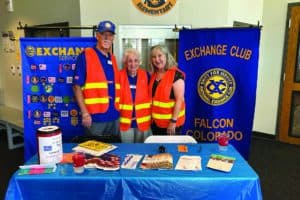At 5 p.m. on Aug. 7, 1904, the St. Louis World’s Fair Flyer pulled out of Denver, Colo., scheduled to arrive in Colorado Springs at 7:05 p.m. and continue on to Pueblo, Colo. where it would turn east, bound for Kansas City and St. Louis, Mo.The destination for some on board that day was the World’s Fair in St. Louis.With a top speed of 47 mph, the Flyer was the fastest passenger train operated by the Denver & Rio Grande Railroad. Its single locomotive pulled seven cars ñ an express car (which carried a safe), a chair car (which was so full that day that some passengers had to stand in the isle), a baggage car, a smoking car, two Pullman sleeping cars and a dining car, in that order.The train arrived at the Colorado Springs depot on schedule and departed shortly thereafter, heading south for Pueblo, passing through land that had been inundated by rain for the previous three days.At Fountain, Mr. Galbreath, a passenger in the second Pullman, noticed piles of hail beside the track, and from that point the train traveled at no more than 15 mph.ìMurky clouds obscured the horizon and the stars were hidden; the lightning’s constant flash was blinding,î he would later write.About 7 miles outside Pueblo, near Eden, Colo., as the train approached the bridge crossing Steeles Hollow (normally a dry creek); a flash flood sent a wall of water over the bridge.The engine reared up and turned to the right before falling. The chair, baggage and smoking cars de-coupled, plunging into the rushing water. They were swept away in water that was now 50 feet across and 15 feet deep.The two Pullman cars and dining car remained on the track, thanks to the quick action of porter W.M. Sales, who pulled the emergency air brake. The locked wheels prevented the cars from plunging into the torrent. Sales was credited for saving 16 lives.In the second Pullman car, it was 10 minutes before Galbreath realized this was more than an unplanned stop. He wrote that his wife, Bessie ìwent to the forward end of our car and came back crying, ‘Oh, the engine is in the ditch.’îStill, he did not believe her.ì(I) went forward myself into the sleeper ahead of us, which I found deserted, and looking out the door in the forward end was horrified to find that it hung over the angry muddy rushing waters. There was no bridge over the chasm in front and no sign of cars or engine,î he wrote.ìWe gazed down into the dark waters as they rushed along and wondered if they could tell us what fate had befallen those in front of us, but they answered us not a word. We wandered up and down, up and down the bank of the rushing torrent, shouting to attract the attention of any who might be in distress and need of aid. Our shouts were answered by echoes alone.ìWe built a fire on the bank of the roaring waters. … It must have been an hour and a half, perhaps two hours, after the wreck, when a man with a lantern appeared on the opposite side of the arroyo and asked us how many were left,î Galbreath wrote.He replied there were 29 men, women and children.Galbreath then asked, ìWhere is the rest of our train?î and the man said, ìDown there in the water.”About a mile away, F. M. Jones, the station agent at Pinon, Colo., and his wife heard the crash and made their way to the site. There, Jones found crew member Frank Mayfield, a fireman, wandering in a daze, unable to remember how he had survived the crash, whether the bridge had collapsed under the weight of the locomotive or was gone before the train reached it.Jones sounded the alarm by telegraph; and, by midnight, a train carrying every available nurse and physician departed Pueblo for the crash site. It was followed by a second train carrying an undertaker, coffins, stretchers and 25 policemen and their chief, Mr. Shoup.They arrived to find the survivors huddled in the rain. The locomotive rested underwater nearby. Soon, the receding water would reveal that Henry Hinman, the engineer, was seated in its cab, his hand still at the throttle. (Other accounts say Hinman’s body was found 200 feet from the accident site.)Nearby was the express car, which carried a safe. Its doors were open; its contents gone.In all, more than 500 people searched for survivors; their lanterns and torches visible in the darkness for miles.The bodies of two women and a girl no more than 15 years old ñ all so covered with mud they could not be identified ñ were the first to be recovered. Occupants of the chair car, they were found a half mile below the wreck near the point at which the flood waters flowed into Fountain Creek.The chair car was found in Fountain Creek, a mile from the accident site, half-filled with sand that covered many bodies. J. M. Killin, a Pueblo hardware merchant, was one of three who escaped from the chair car.Killin was quoted as saying, ìIt was just as though the train had struck a stone wall. The lights went out, the fixtures and everything fell down and the passengers were thrown forward, and there were the most awful cries for help, and the grinding of timbers.ìThen another crash came and the train seemed to sink about 5 feet. Ö I knew I was in terrible danger. Ö In another crash, I was thrown about a third of the length of the car right up against the front door. I grabbed the top of the door, and the car went over in the water three times. … The car naturally righted and when it came up, the water was just above my lips.îKillin escaped by smashing a window; he then struggled to reach shore.The smoking car was found 3 miles past the chair car. Three passengers had survived by climbing through a hole in the ceiling.By morning, only puddles remained in the creek bed. Now it was quicksand ñ not water ñ that impeded the searchers’ progress.The body of a beautiful woman was found in the Arkansas River at Vivian, Colo. With the exception of a single glove, all her clothes had been torn from her body in the 22-mile journey from the accident site. (Other reports say she was fully clothed.) ìShe had few bruises, and her body was white and glistening in the water as though she still lived. Mud and sand so clotted her hair, it was impossible to tell its color.îThe body of a man found floating in the Arkansas was so battered it could not be identified.The exact number of deaths could not be determined because it was unknown how many people were actually on the train that evening. The highest estimate is that 149 passengers were on board.At least 100 were buried, the majority of them from Pueblo and Denver. Some were never found.What became known as the Eden Train Wreck made headlines in the ìNew York Times,î which declared it ìone of the greatest railroad disasters in the history of the country.îTwo locomotives were sent from Colorado Springs to drag the three cars still on the tracks back to the Colorado Spring depot.Within 24 hours, the bridge was rebuilt and train traffic resumed normal operations.





